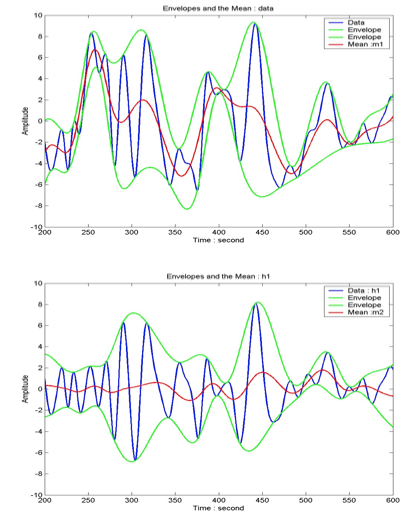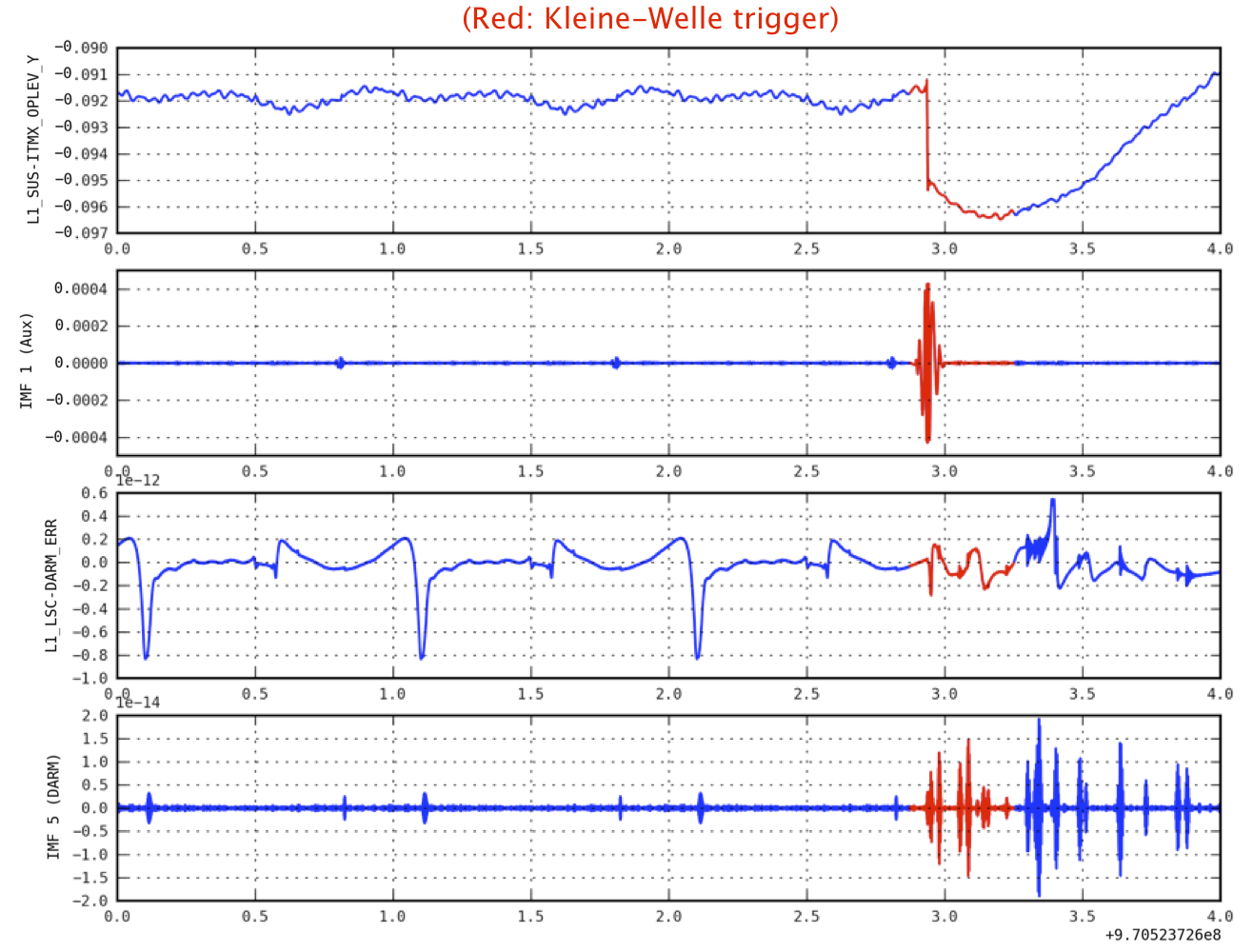|
Size: 396
Comment:
|
Size: 5273
Comment:
|
| Deletions are marked like this. | Additions are marked like this. |
| Line 2: | Line 2: |
| ==== Project Description ==== * Introduction: Hilbert-Huang Transform (HHT) HHT is a recently suggested empirical data transform based on adaptive bb ==== Goal ==== |
==== Project Description and Goal ==== * Member: John J. Oh, Sang Hoon Oh, Edwin J. Son (NIMS), Young-Min Kim (Pusan National Univ.), Kazuhiro Hayama (Osaka Univ.) * Used Data: S6 Auxiliary Channel Data, KAGRA Seismic/Magnetometer Data * Goal: Developing an improved trigger generation scheme using HHT - comparing KW triggers (and others) ==== Introduction: Hilbert-Huang Transform (HHT) ==== {{attachment:emds.png||align="left"}} HHT is a recently suggested empirical data transform based on adaptive bases. So it is very useful for analyzing non-linear and/or non-stationary data. The HHT consists of two main parts: 1) empirical mode decomposition (EMD) 2) Hilbert spectral analysis (HSA). The EMD can decompose the original data into some appropriate data sets that contributes to some frequency bands. Basically the EMD is described by a sifting processes with {{https://upload.wikimedia.org/math/e/e/4/ee4471f673afaddfc791f692cf250f6b.png}}, which shows that the EMD performs the subtraction between the original data (or the previously generated data) and its average of envelopes, repeatedly, called '''''intrinsic mode functions (IMF)''''', expressed by {{https://upload.wikimedia.org/math/7/e/c/7ec2bae54bcdd79fab725ef8d6c5314c.png}} and {{https://upload.wikimedia.org/math/6/5/3/65349fc2c693c1b809562b59f4b5e172.png}}. And the normalized squared difference (NSD) between two successive sifting operations is defined as {{https://upload.wikimedia.org/math/1/8/a/18aba9375519cd1b75a761363eea55b7.png}}, which should be small. The stoppage criterion of this process is determined by comparing between the NSD and the predetermined value - if NSD is smaller than a predetermined value, the process is stopped. The Hilbert transform of the ''EMDed data'' consists of the amplitude and phase parts and we see that the original data can be expressed by the summation of the whole IMFs, which is {{https://upload.wikimedia.org/math/6/f/d/6fdad0aefbac705612d1e8541fcd9eef.png}}. Comparing to the (Fast) Fourier Transform (FFT), {{https://upload.wikimedia.org/math/2/7/7/277cc4bee5968c6ca2d4c78747d18689.png}}, we easily see that the HHT deals with the time-variant amplitude and phase data with adaptive bases. We compare the HHT to other two different transforms in the following table. ||<bgcolor="#E0E0FF"> ||<style="text-align: center;background-color: #E0E0FF;"> Fourier ||<style="text-align: center;background-color: #E0E0FF;"> Wavelet ||<style="text-align: center;background-color: #E0E0FF;"> Hilbert-Huang || ||<style="text-align: center;background-color: #E0E0FF;"> Basis ||<style="text-align: center;"> a priori ||<style="text-align: center;"> a priori ||<style="text-align: center;"> Adaptive || ||<style="text-align: center;background-color: #E0E0FF;"> Frequency ||<style="text-align: center;"> Integral transform: Global ||<style="text-align: center;"> Integral transform: Regional ||<style="text-align: center;"> Differentiation: Local || ||<style="text-align: center;background-color: #E0E0FF;"> Presentation ||<style="text-align: center;"> Energy-Frequency ||<style="text-align: center;"> Energy-Time-Frequency ||<style="text-align: center;"> Energy-Time-Frequency || ||<style="text-align: center;background-color: #E0E0FF;"> Nonlinearity ||<style="text-align: center;"> No ||<style="text-align: center;"> No ||<style="text-align: center;"> Yes || ||<style="text-align: center;background-color: #E0E0FF;"> Non-stationarity ||<style="text-align: center;"> No ||<style="text-align: center;"> Yes ||<style="text-align: center;"> Yes || ||<style="text-align: center;background-color: #E0E0FF;"> Uncertainty ||<style="text-align: center;"> Yes ||<style="text-align: center;"> Yes ||<style="text-align: center;"> No || ||<style="text-align: center;background-color: #E0E0FF;"> Harmonics ||<style="text-align: center;"> Yes ||<style="text-align: center;"> Yes ||<style="text-align: center;"> No || |
| Line 8: | Line 30: |
* HHT-based Trigger Check with S6 LIGO Data * Data: L1_SUS_ITMX_OPLEV_Y / L1_LSC-DARM_ERR * Method: HHT operation / KW Trigger at given GPS time * EMD Decomposition and HSA Trigger Generation / Comparison with KW Trigger (red) {{attachment:S6HHT_KW.png|alt Comparison btw HHT & KW triggers of S6 aux. channel Data |width=800 height=250}} * Data: S6_968654557 (Big Dog Event) * Method: HHT operation / Big Dog time (around 8 sec in IMF3) * EMD Decomposition and HSA Trigger Generation (green) {{attachment:S6HHT_BigDog.png|alt Big Dog Trigger seen in HHT |width=800 height=250}} * HHT-based Trigger Check with KAGRA Data * Data: 20131023_SEISMIC_SEI_NS_00000-00128 * Method: HHT operation * EMD Decompostion / HSA - marking in GPS time (green) {{attachment:20131023_seismic_SEI_NS_00000-00128_emd_0.png|alt HHT Triggers of KAGRA Seismic Data |width=850 height=250}} * Power Spectrum Density (Energy-Frequency Map) {{attachment:20131023_seismic_SEI_NS_00000-00128_psd.png|alt PSD of KAGRA Seismic Data |width=850 height=250}} |
HHT based Instrumental Glitch Trigger Generation
Project Description and Goal
- Member: John J. Oh, Sang Hoon Oh, Edwin J. Son (NIMS), Young-Min Kim (Pusan National Univ.), Kazuhiro Hayama (Osaka Univ.)
- Used Data: S6 Auxiliary Channel Data, KAGRA Seismic/Magnetometer Data
- Goal: Developing an improved trigger generation scheme using HHT - comparing KW triggers (and others)
Introduction: Hilbert-Huang Transform (HHT)

HHT is a recently suggested empirical data transform based on adaptive bases. So it is very useful for analyzing non-linear and/or non-stationary data. The HHT consists of two main parts: 1) empirical mode decomposition (EMD) 2) Hilbert spectral analysis (HSA). The EMD can decompose the original data into some appropriate data sets that contributes to some frequency bands. Basically the EMD is described by a sifting processes with
 , which shows that the EMD performs the subtraction between the original data (or the previously generated data) and its average of envelopes, repeatedly, called intrinsic mode functions (IMF), expressed by
, which shows that the EMD performs the subtraction between the original data (or the previously generated data) and its average of envelopes, repeatedly, called intrinsic mode functions (IMF), expressed by  and
and  . And the normalized squared difference (NSD) between two successive sifting operations is defined as
. And the normalized squared difference (NSD) between two successive sifting operations is defined as
 ,
,
which should be small. The stoppage criterion of this process is determined by comparing between the NSD and the predetermined value - if NSD is smaller than a predetermined value, the process is stopped.
The Hilbert transform of the EMDed data consists of the amplitude and phase parts and we see that the original data can be expressed by the summation of the whole IMFs, which is
 .
. Comparing to the (Fast) Fourier Transform (FFT),
 , we easily see that the HHT deals with the time-variant amplitude and phase data with adaptive bases. We compare the HHT to other two different transforms in the following table.
, we easily see that the HHT deals with the time-variant amplitude and phase data with adaptive bases. We compare the HHT to other two different transforms in the following table.
|
Fourier |
Wavelet |
Hilbert-Huang |
Basis |
a priori |
a priori |
Adaptive |
Frequency |
Integral transform: Global |
Integral transform: Regional |
Differentiation: Local |
Presentation |
Energy-Frequency |
Energy-Time-Frequency |
Energy-Time-Frequency |
Nonlinearity |
No |
No |
Yes |
Non-stationarity |
No |
Yes |
Yes |
Uncertainty |
Yes |
Yes |
No |
Harmonics |
Yes |
Yes |
No |
Preliminary Analysis of HHT
- HHT-based Trigger Check with S6 LIGO Data
- Data: L1_SUS_ITMX_OPLEV_Y / L1_LSC-DARM_ERR
- Method: HHT operation / KW Trigger at given GPS time
- EMD Decomposition and HSA Trigger Generation / Comparison with KW Trigger (red)
- Data: S6_968654557 (Big Dog Event)
- Method: HHT operation / Big Dog time (around 8 sec in IMF3)
- EMD Decomposition and HSA Trigger Generation (green)
- HHT-based Trigger Check with KAGRA Data
- Data: 20131023_SEISMIC_SEI_NS_00000-00128
- Method: HHT operation
- EMD Decompostion / HSA - marking in GPS time (green)
- Power Spectrum Density (Energy-Frequency Map)
Trigger Generation Method
Simulation Results




